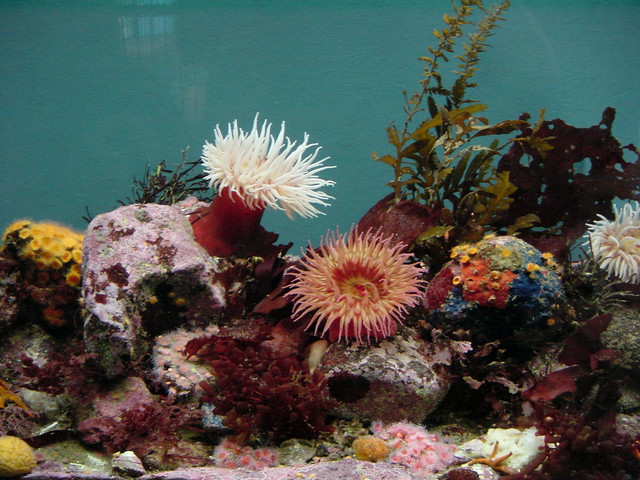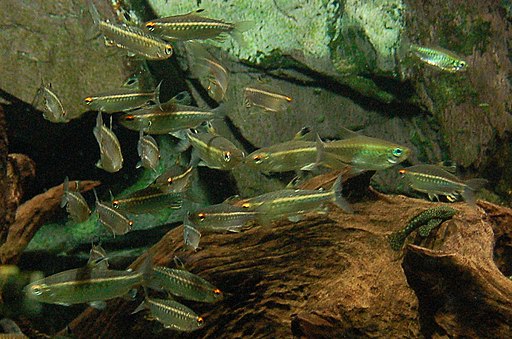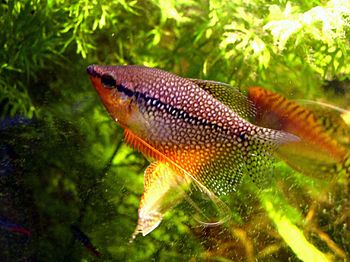Out of all the chameleons in the world, the Parson's Chameleon is said to be the largest when it comes to weight. They reach the size of a house cat, and the tail can stretch to be longer than the body. These large reptiles are native to eastern Madagascar and are very popular among collectors due to their size and also the wide appeal of the chameleon's appearance.
 |
| Parson's Chameleon - Photo0: Wikimedia |
These brilliantly colored lizards are characterized by their gray or brownish colorings as juveniles, but the colors and patterns change depending upon the different life stage they may be in. Dark banding runs diagonally across the thick body of this chameleon. In adulthood, colors that are present include greens and blues. Some males can exhibit orange eyelids and even yellow or white lips. A dorsal crest is sometimes present in males, as well as two rostral appendages. They look like two tiny horns.
The natural habitat for this amazing reptile is low and mid-altitude rainforests. They seem to have a preference of being near moving water and are very often found next to streams. They are very seldom if ever seen on the ground, instead preferring the canopy of trees and the security and prey they provide.
The Parson's chameleon is an omnivore, munching regularly on small lizards, birds and perhaps even small mice when it's looking for a meaty meal. Other items on the menu for this bruiser include leaves, flowers, and also many different kinds of fruits. For a water source, many owners choose to use some sort of drip system.
Chameleons are notorious for not drinking from standing water, preferring to take their hydration as it drips from leaves or trickles from a waterfall. Like other chameleons, the Parson's chameleon can extend its tongue to one and a half times its body length to capture prey.
Perhaps mostly because of its size, the Parson's chameleon seems to be popular with people who keep reptiles. It is a particularly slow moving specimen and may appear to be a bit lazy. This should not, however, fool you into thinking you can house this chameleon in a smaller sized cage. It still needs plenty of room to roam about. Room- sized cages that offer plenty of hiding spots seem to make the Parson's chameleon happy.
When it comes to home habitat, the Parson's chameleon has requirements that are similar to other chameleons. They need things to climb on, preferably live vegetation. They prefer the temperature to be on the warm side, up to 85 degrees Fahrenheit during the day and not dipping below 65 degrees at night. Humidity should be on the high side to mimic their natural habitat in the wild. We recommend 80 to 100 percent humidity levels.
Cages should be constructed from sturdy materials. No glass or plastic, as it doesn't allow for any air exchange within the cage. They live in the trees - they need plenty of ventilation. Parsons is a solitary creature and will exhibit signs of stress when they are subjected to overcrowding, and with Parsons, two's a crowd unless it's time to mate.
Breeding males will actually butt heads to try to establish who is more dominant. The females only breed once every two years. They can lay up to 25 eggs. The eggs incubate for an incredible twenty months.
Knowing what to look for when selecting a Parson's chameleon can help with your enjoyment of this fascinating reptile. Remember, the life span of these guys can be over six years. Check to see if the skin springs back when it is lightly pinched. If not, the chameleon is dehydrated. Also look to see how active it is. A reluctance to climb or even move about could be a sign that the reptile is not very healthy. Another point to look for is eyes that are constantly open. Chameleons are said to never close their eyes in the daytime.
As with any exotic, the best way to keep the Parsons Chameleon healthy is to maintain a habitat that resembles his native habitat as closely as possible. Learn about his geographical area and have the enclosure ready before you purchase your Parsons Chameleon.
Article Source: EzineArticles |





